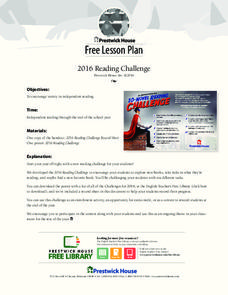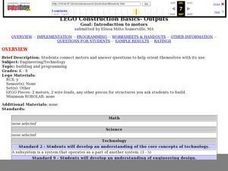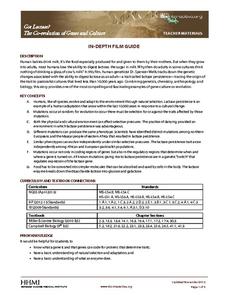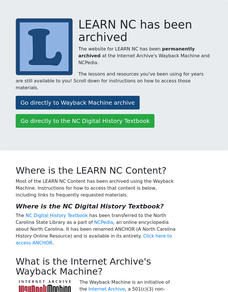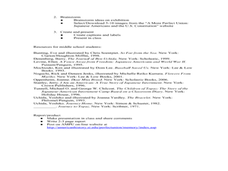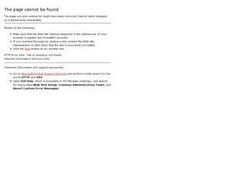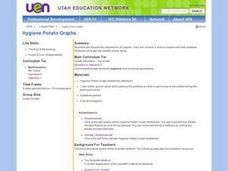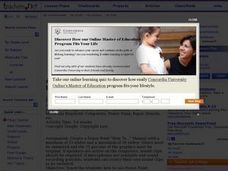ESL Kid Stuff
Time Frequency - "How Often ...?"
How often do you ride a bike? Time frequency words are featured in a lesson designed for ESL/ELD classrooms.
ESL Kid Stuff
Vegetables
Help your learners exercise healthy eating habits with a series of activities about vegetables. Kids learn about common vegetables with songs, matching games, flashcards, and crafts.
Prestwick House
Reading Challenge
One of the big challenges of assigning independent reading is helping class members find a book to read. Another is encouraging readers to read a variety of genres. Never fear, help is here in the form of a quest that asks individuals to...
Civil War
Civil War Medicine: Fact or Fiction
Young historians compare the presentation of medical care during the Civil War in passages from fictional and nonfictional texts. They examine passages from Gone with the Wind by Margaret Mitchell and Soldier's...
National Nanotechnology Infrastructure Network
Introduction to Nanotechnology Using the Creative Problem-Solving Model
Should we continue to spend money on nanotechnology? Groups engage in a problem-solving unique process around the newly emerging research field of nanotechnology. In order to propose a solution, the groups must research nanotechnology...
Elizabeth Murray Project
The Education of Women in Colonial America
What educational opportunities were available to women during the colonial era in American history? How did the opportunities available to women differ from those for men? To answer this question, class members examine a series of...
ESL Kid Stuff
Toys
The world is a rainbow of colors in a set of lessons for English learners. Kids review colors with matching games and hide-and-seek, before singing songs about colors and reading a class story.
Kentucky Department of Education
Multiplication Grade 3 Formative Assessment Lesson
Guide multiplication lesson plan instruction with a formative assessment. Mathematicians are given two multiplication problems to solve and represent using the area model, equal groups, repeated addition, and word problems. Following the...
Center for Learning in Action
Water—Changing States (Part 1)
Here is part one of a two-part lesson in which scholars investigate the changing states of water—liquid, solid, and gas. With grand conversation and up to three demonstrations, learners make predictions about what they think will happen...
Curated OER
LEGO Construction Basics-Outputs
Students connect motors and explain the function of the different ports and wires. They follow specific directions given by the teacher pertaining to the RCX and the program buttons of the motor. They participate in a worksheet/handout...
Curated OER
Organic and Inorganic Waste
Students conduct a scientific investigation about organic or inorganic waste. In this organic or inorganic waste lesson, students create a compost heap to determine the difference between inorganic and organic waste. Students...
Howard Hughes Medical Institute
Got Lactase? The Co-Evolution of Genes and Culture
Does the human body evolve as quickly as human culture? With a stellar 15-minute video, explore the trait of lactose intolerance. Only about 1/3 of human adults seem to still have the enzyme lactase and therefore, the ability to digest...
Curated OER
"Three Cool Kids"
First graders discuss literary elements: characters, setting, problem and solution, after reading Three Cool Kids by Rebecca Emberley. The teacher records what students say using Inspiration, making a web that shows the different...
Curated OER
Smithsonian Asian Pacific American Program
Here’s the overview for a series of lessons about the Japanese American internment introduced by the resource entitled “A Fence Away From Freedom.” Included are the link to the Smithsonian website on which the lessons are based, a list...
Curated OER
Exhibiting Art
Students create a brochure for an art gallery combining research and images pertaining to known art works such as Van Gogh - Self Portrait and art pieces of the students. Students use their own artwork and download images from the and...
Curated OER
Hygiene Potato Graphs
Fifth graders discuss the importance of proper hygiene. After watching their teacher peel potatoes, they discuss why she was wearing rubber gloves. They demonstrate how to wash their hands properly and why one should never touch...
Curated OER
Enhancing Literacy with Podcasting
Students write stories, print hard copies, and use the GarageBand program to add music and record the narrations. A handout to download, of instructions is included in this early-elementary lesson.
Alabama Learning Exchange
Simple Machines Webquest
Middle schoolers explore simple machines through a Webquest with Internet resources provided for research of simple machines. They create a report, with pictures, in Word, and finally, invent their own simple machine for presentation.
Curated OER
Writing and Creating with Power Point
Learners explore the process of creating a Powerpoint presentation. They choose a "How to" topic, conduct research, organize their ideas, and develop and present their Powerpoint presentation.
Curated OER
Triangle Exploration
Students are introduced to The Geometer's Sketchpad software while in the computer lab. They focus on triangles, horizontal lines, vertex and top parallel lines. Each student utilizes geometry to complete basic geometric constructions.
Curated OER
Steroids
Students examine the problem of anabolic steroid abuse. They watch a PowerPoint presentation, identify and discuss resources available to help people with substance abuse problems, and develop a prevention plan to prevent steroid abuse...
Curated OER
Using PowerPoint in the Classroom
Students acquaint themselves with Microsoft PowerPoint. They describe the basic features with the program and choose a presentation style. They create their own short slide show.
Curated OER
Alzheimer's Disease
Investigate Alzheimer's disease. Conduct research using a variety of resources, obtain information, and input the data into a Microsoft Excel spreadsheet. Identify trends in the data and categorize them for an audience.
Curated OER
Where We Live
Students practice the click and drag technique on the computer as they match pictures of activities in the home, school, and community to the correct boxes. Then they will write about the activities.


